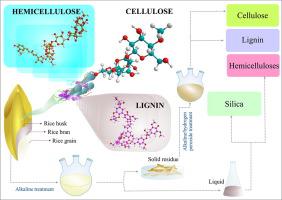Journal of Industrial and Engineering Chemistry ( IF 5.9 ) Pub Date : 2022-01-04 , DOI: 10.1016/j.jiec.2021.12.032 Ngoc Thuy Nguyen 1, 2, 3 , Nhat Thong Tran 1, 2, 3 , Tan Phat Phan 1, 2, 3 , Anh Thu Nguyen 1, 2, 3 , My Xuyen T. Nguyen 1, 2, 3 , Nguyen Ngan Nguyen 1, 2, 3, 4 , Young Ho Ko 3, 4, 5 , Dai Hai Nguyen 3, 4 , Tran T.T. Van 1, 2, 3 , DongQuy Hoang 1, 2, 3

|
While the efficient usage of biomass waste can significantly help in addressing environmental issues, there are only a few reports that discuss about processing such waste effectively at a low-cost. Such challenge arises from the strong association between the components biomass. In this study, an abundant agricultural byproduct, rice husk (RH), was used as the starting resource. A simple biorefining process of alkaline peroxide treatment followed by acid precipitation and ethanol extraction was performed on RH to obtain cellulose, hemicellulose, lignin, and silica. The chemical structures, morphologies, and physic-chemical properties of the separated components were identified through a wide range of characterization approaches. The final products obtained from of this process were (i) bundles of fiber-like cellulose with a fiber width of 6 µm and (ii) small particles of hemicellulose and lignin with non-uniform shapes. The lignocelluloses products had over 90 wt% carbon with 52.28% crystalline ratio. Meanwhile, the other products comprising hemicelluloses, lignin, and silica were amorphous. The outcome of this study contributes to expanding and developing the simple and efficient conversion process of biomass waste into sustainable value-added materials. It is crucial to reduce the environmental impact by using renewable materials as the new building block resources for synthetic chemicals.
中文翻译:

单一生物精炼工艺从稻壳中提取木质纤维素和二氧化硅及其特性
虽然生物质废物的有效利用可以显着帮助解决环境问题,但只有少数报告讨论了以低成本有效处理此类废物。这种挑战来自生物质成分之间的强关联。在这项研究中,一种丰富的农业副产品稻壳(RH)被用作起始资源。在 RH 上进行碱性过氧化物处理、酸沉淀和乙醇提取的简单生物精制过程,以获得纤维素、半纤维素、木质素和二氧化硅。通过广泛的表征方法确定了分离组分的化学结构、形态和物理化学性质。从这个过程中获得的最终产品是 (i) 纤维状纤维素束,纤维宽度为 6 µm,和 (ii) 半纤维素和木质素的小颗粒,形状不均匀。木质纤维素产品具有超过 90 wt% 的碳和 52.28% 的结晶率。同时,包含半纤维素、木质素和二氧化硅的其他产品是无定形的。这项研究的结果有助于扩展和开发将生物质废物简单有效地转化为可持续增值材料的过程。通过使用可再生材料作为合成化学品的新基石资源来减少对环境的影响至关重要。包含半纤维素、木质素和二氧化硅的其他产品是无定形的。这项研究的结果有助于扩展和开发将生物质废物简单有效地转化为可持续增值材料的过程。通过使用可再生材料作为合成化学品的新基石资源来减少对环境的影响至关重要。包含半纤维素、木质素和二氧化硅的其他产品是无定形的。这项研究的结果有助于扩展和开发将生物质废物简单有效地转化为可持续增值材料的过程。通过使用可再生材料作为合成化学品的新基石资源来减少对环境的影响至关重要。











































 京公网安备 11010802027423号
京公网安备 11010802027423号